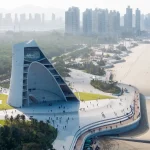
When we gaze at the stunning works of Antoni Gaudí, we are easily tempted to concentrate purely on their beauty. Nevertheless, deep beneath their ornate surfaces lies an organic connection to nature and the precision of maths. Gaudí, in his approach to architecture, was far ahead of his time, fusing natural geometry with complex mathematics to create spaces that seem to come alive. His innovative techniques—catenary arches, hyperbolic paraboloids, and fractal patterns—position him as a precursor to contemporary parametric design, long before the advent of digital tools like Grasshopper and Rhino.
A revisiting of the principles of Gaudí in this era overwhelmed by the rise of computational and biomimetic architecture reveals their relevance for architects working towards harmonizing technology with nature. In one of the iconic buildings where undulating façades were used, Casa Batlló, or in the wonderful works of hyperboloid vaults of the Sagrada Família, Gaudí’s works represent an ingenious fusion of science, art, and sustainability that continues to shape the architectural discourse.

The Visionary Relationship Between Nature and Geometry for Antoni Gaudí
Gaudí considered architecture a continuation of the works of nature. He studied with an eye for detail the shapes and patterns of the natural world, translating their intrinsic logic into built structures. This helps explain why his design philosophy rejected rigid orthogonality in architecture and moved toward curves, asymmetry, and fluidity.

Biomimicry in Gaudí Architecture
Nature-inspired elements are seen throughout Gaudí’s works. The façade of Casa Batlló, for example, speaks of an underwater shimmering world since it follows waving lines and texture mosaic-like. He also designed inside ergonomic, shell-like staircases and light wells that mimic the nature cave formation. These organic designs not only were aesthetic but functional as well, improving ventilation and lighting.
Mathematics as a Design Tool in Gaudí Architecture
For Gaudí, mathematical principles were the source of inspiration as well as structural foundation for his works. Unlike most architects during his time, Gaudí employed such advanced geometric forms based on nature to solve some of the most complicated architectural challenges.

The Geniality of Catenary Arches
Gaudí very widely adopted catenary arches-a form created by the natural curve of an inverted hanging chain-to achieve stable yet light structures. In Sagrada Família, these arches distribute weight nicely, allowing for high structures and intricately vaulted structures that mimic the curving of tree trunks.

Hyperboloids and Paraboloids
Hyperbolic forms for windows and vaults at the Sagrada Família enable natural light to cascade into interior spaces, creating an otherworldly ambiance. These geometric inventions were designed carefully and by many decades well before their time, reflecting concepts now dear to parametric design.
Fractals and Patterns in Gaudí’s Work
Fractals—repeating patterns at different scales—are another key feature of Gaudí’s designs. Mosaic tiles in fractal-like patterns in Park Güell mirror the colours and textures of the surrounding landscape to create a seamless, harmonious architecture-environment merge, emblematic of today’s sense of urgency around sustainable design.
Gaudí as a Parametric Design Pioneer
Gaudí’s techniques share striking similarities with modern parametric architecture. His use of physical models-hanging chains and weighted nets-to simulate complex curves and shapes is an analogue precursor to the algorithms used in tools like Grasshopper. His focus on form-finding processes and incorporation of natural principles has paved the way for a new era of computational architecture.
Today, architects draw inspiration from his work, using digital tools to create biomimetic and mathematically derived designs. Gaudí’s influence is evident in contemporary projects like fluid forms by Zaha Hadid Architects or BIG’s nature-inspired urban landscapes.

Lessons from Gaudí for Modern Design
The growth in biomimicry and computational tools around the world reflects the timeless significance of Gaudí’s philosophy. His work shows that the blend of nature, art, and mathematics may lead to beautiful, ecologically friendly, and structurally sound architecture.

Bridging Timeless Principles with Modern Innovation
Antoni Gaudí was not only an architect but also an idea man who led the way between art and science. His natural geometry and mathematical logic founded a tradition that continues to inspire architects today. As we incorporate the parametric and generative design technologies into our current systems, re-reading Gaudí’s time-defying methodology reminds us how creativity may mix with scientific discipline. At a time of digital progression, Gaudí’s organic, human-centered approach to architecture is becoming more relevant than ever.
Now Stay Ahead with PAACADEMY
Check out the workshops at PAACADEMY-these are a good way to get your hands on the latest digital design tools. The industry experts leading the sessions are here to help you keep your edge sharp and inspired in this ever-changing field.


















Leave a comment